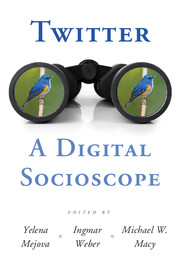2 - Political Opinion
Published online by Cambridge University Press: 05 May 2015
Summary
Despite being a fairly recent phenomenon, microblogging has attracted a large number of researchers and practitioners who consider microposts a suitable source of data to ascertain public opinion. Among the reasons for that interest, we may find the fact that one single platform (i.e., Twitter) is the default choice for users; the ease with which one can collect data using public application programming interfaces (APIs); and the brevity of microposts, which forces users to get to the point when discussing any given topic.
This chapter is focused on efforts to exploit Twitter data to scrutinize public opinion in general, and political discussion in particular. It covers representative case studies conducted during the late 2000s and early 2010s and discusses their respective limitations. Finally, we analyze the implications of such approaches to political opinion in Twitter and depict important lines of research to further advance the field.
Introduction
This chapter is devoted to the problem of exploiting Twitter data to take the pulse of public opinion, particularly with regard to electoral forecasting. However, most of the arguments exposed here are not limited to Twitter, but apply broadly to any social networking site.
Twitter is (at the moment of this writing) the most convenient way to obtain user-generated content of opinionated nature about current events. That is the main reason why so much research has been performed on that platform and, in turn, such high expectations have been put on mining Twitter data.
For an in-depth overview of Twitter, in particular its historical evolution, consult the work by Van Dijck (2013, pp. 68–88). Rogers (2013) also analyzes Twitter's evolution, but mainly from a research perspective. His work shows the way in which research has evolved together with the service. In this regard, he provides compelling arguments to drop, once and for all, the caricatured image of Twitter as “pointless babble” and to acknowledge finally that it “serves as a mean to study cultural conditions.” Indeed, that simple idea pervades this chapter and the rest of the book.
- Type
- Chapter
- Information
- Twitter: A Digital Socioscope , pp. 52 - 74Publisher: Cambridge University PressPrint publication year: 2015
References
- 2
- Cited by

